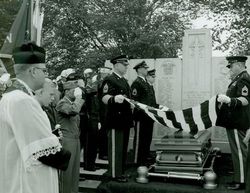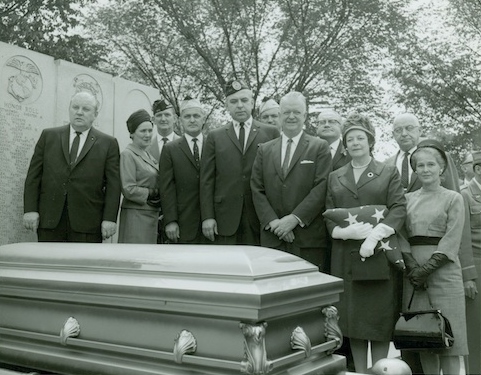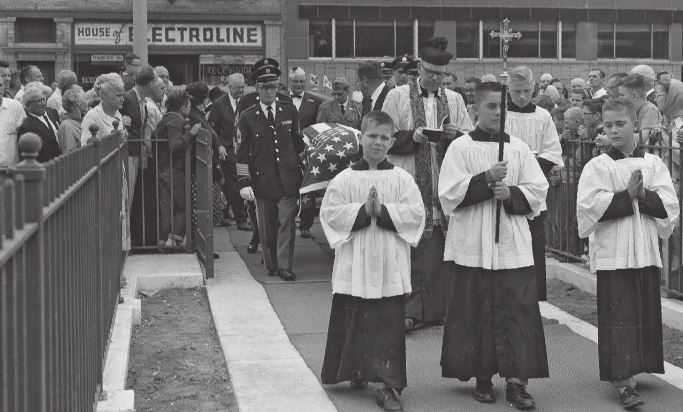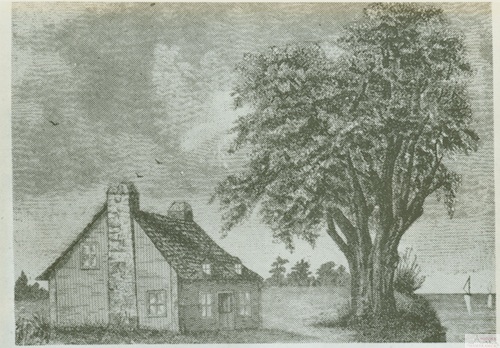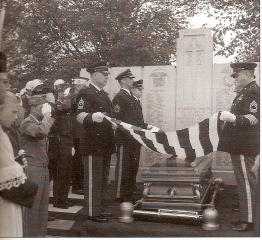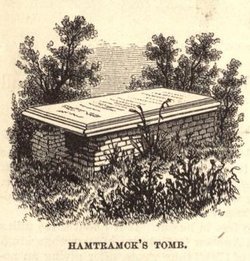Hamtramck Township once had the largest borders in Wayne County, Michigan extending north to 8-mile road(Baseline, county line) east to the Detroit River, also into the Grosse Pointes and west to Woodward Ave in Detroit. The land was annexed by Detroit and other communities throughout the 19th and early 20th centuries and by 1922 the area was down to barely two square miles which by that time Hamtramck was incorporated into a city to avoid further annexation. In 1910 John and Horace Dodge put Hamtramck on the map, by building their automotive plant here. Unfortunately, no portraits are known to exist of Col. Hamtramck's image.
Sources: Hamtramck The Driven City by Greg Kowalski, (Which I must add is an excellent book with more historical information on Col. Hamtramck), Arcadia Publishing.
"Images of America" Hamtramck Soul of a city.
*Col. Hamtramck is not in a memorial park cemetery, his remains are interred in a public memorial park in Hamtramck. Do not contact administrators to change this.∼Born abt 1755, Col John Francis Hamtramck was first interred at St. Anne Church in 1803. In June of 1866, his remains were moved to Mt. Elliott, Sec. 71, Lot 507. On May 26, 1962, he was moved again to Memorial Park in Hamtramck, where his grave was made into a civic memorial.
He was a Canadian-born professional soldier who served valiantly on the American side during the Revolutionary War. He bought a farm east of Detroit, and when townships were laid out, Hamtramck Township was named for him.
Source: Mt Elliott Cemetery, A History, Est. 1841, p 45
∼JOHN FRANCIS HAMTRAMCK ESQ.
aka Colonel Jean Francois Hamtramck
Resident of Northern New York when the Revolution broke out, and was a captain in the Continental army. He was appointed a major in the regular army of the United States in September, 1798, and was promoted to the lieutenant colonel commandant of the first sub-legion in February, 1793. He commanded the left wing under General Wayne in the battle of the Maumee, in August, 1794, and held the rank of lieutenant colonel in the First Infantry in 1796. He was retained as colonel on the reduction of the army in April, 1802, and on the 11th of April the following year he died and was buried in Detroit.
~~~~~~~~~~~~~~~~~~~~~~~~~~~~~~~~~~~~
The monument is composed of a light freestone slab. It bears the following inscription:
"Sacred to the memory of
JOHN FRANCIS HAMTRAMCK, Esq., Colonel of the First United States Regiment of Infantry, and Commandant of Detroit and its dependencies. He departed this life on the 11th of April, 1803, aged 45 years, 7 months, and 27 days. True patriotism, and zealous attachment to national liberty, joined to a laudable ambition, led him into military service at and early period of his life. He was a soldier even before he was a man. He was an active participator in all the dangers, difficulties, and honors of the Revolutionary War; and his heroism and uniform good conduct procured him the attention and personal thanks of the immortal Washington. The United States, in him, have lost a valuable officer and good citizen, and society a useful and pleasant member. To his family his loss is incalculable, and his friends will never forget the memory of Hamtramck. This humble monument is placed over his remains by the officers who had the honor to serve under his command: a small but grateful tribute to his merit and his worth." ref: The Pictorial field-book of the War of 1812 by Benson John Lossing
============================
Originally buried in Ste. Anne’s graveyard 13 April where he lived in a house in what is now Gabriel Richard Park, at the bridge to Belle Isle, he remained commandant of Fort Wayne until his death. In 1805, his body was moved for a Second time to the new graveyard Ste. Anne de Detroit Catholic Church after fire destroyed the city in 1805. In 1866, his body was moved for the Third time to Mount Elliott Cemetery. In 1962 he was moved for the Fourth and Final time in an honored plot where his grave was incorporated into the Veterans Memorial at the entrance to Veterans Memorial Park, the main city park in Hamtramck, Michigan the city named for him.
JOHN FRANCIS HAMTRAMCK ESQ. - Historically he is possibly Detroit’s most reburied Detroiter~
Hamtramck Township once had the largest borders in Wayne County, Michigan extending north to 8-mile road(Baseline, county line) east to the Detroit River, also into the Grosse Pointes and west to Woodward Ave in Detroit. The land was annexed by Detroit and other communities throughout the 19th and early 20th centuries and by 1922 the area was down to barely two square miles which by that time Hamtramck was incorporated into a city to avoid further annexation. In 1910 John and Horace Dodge put Hamtramck on the map, by building their automotive plant here. Unfortunately, no portraits are known to exist of Col. Hamtramck's image.
Sources: Hamtramck The Driven City by Greg Kowalski, (Which I must add is an excellent book with more historical information on Col. Hamtramck), Arcadia Publishing.
"Images of America" Hamtramck Soul of a city.
*Col. Hamtramck is not in a memorial park cemetery, his remains are interred in a public memorial park in Hamtramck. Do not contact administrators to change this.∼Born abt 1755, Col John Francis Hamtramck was first interred at St. Anne Church in 1803. In June of 1866, his remains were moved to Mt. Elliott, Sec. 71, Lot 507. On May 26, 1962, he was moved again to Memorial Park in Hamtramck, where his grave was made into a civic memorial.
He was a Canadian-born professional soldier who served valiantly on the American side during the Revolutionary War. He bought a farm east of Detroit, and when townships were laid out, Hamtramck Township was named for him.
Source: Mt Elliott Cemetery, A History, Est. 1841, p 45
∼JOHN FRANCIS HAMTRAMCK ESQ.
aka Colonel Jean Francois Hamtramck
Resident of Northern New York when the Revolution broke out, and was a captain in the Continental army. He was appointed a major in the regular army of the United States in September, 1798, and was promoted to the lieutenant colonel commandant of the first sub-legion in February, 1793. He commanded the left wing under General Wayne in the battle of the Maumee, in August, 1794, and held the rank of lieutenant colonel in the First Infantry in 1796. He was retained as colonel on the reduction of the army in April, 1802, and on the 11th of April the following year he died and was buried in Detroit.
~~~~~~~~~~~~~~~~~~~~~~~~~~~~~~~~~~~~
The monument is composed of a light freestone slab. It bears the following inscription:
"Sacred to the memory of
JOHN FRANCIS HAMTRAMCK, Esq., Colonel of the First United States Regiment of Infantry, and Commandant of Detroit and its dependencies. He departed this life on the 11th of April, 1803, aged 45 years, 7 months, and 27 days. True patriotism, and zealous attachment to national liberty, joined to a laudable ambition, led him into military service at and early period of his life. He was a soldier even before he was a man. He was an active participator in all the dangers, difficulties, and honors of the Revolutionary War; and his heroism and uniform good conduct procured him the attention and personal thanks of the immortal Washington. The United States, in him, have lost a valuable officer and good citizen, and society a useful and pleasant member. To his family his loss is incalculable, and his friends will never forget the memory of Hamtramck. This humble monument is placed over his remains by the officers who had the honor to serve under his command: a small but grateful tribute to his merit and his worth." ref: The Pictorial field-book of the War of 1812 by Benson John Lossing
============================
Originally buried in Ste. Anne’s graveyard 13 April where he lived in a house in what is now Gabriel Richard Park, at the bridge to Belle Isle, he remained commandant of Fort Wayne until his death. In 1805, his body was moved for a Second time to the new graveyard Ste. Anne de Detroit Catholic Church after fire destroyed the city in 1805. In 1866, his body was moved for the Third time to Mount Elliott Cemetery. In 1962 he was moved for the Fourth and Final time in an honored plot where his grave was incorporated into the Veterans Memorial at the entrance to Veterans Memorial Park, the main city park in Hamtramck, Michigan the city named for him.
JOHN FRANCIS HAMTRAMCK ESQ. - Historically he is possibly Detroit’s most reburied Detroiter~
Gravesite Details
Veterans Memorial Park (not a cemetery), south end of the city, on Jos. Campau Ave.
Family Members
Advertisement
Advertisement
